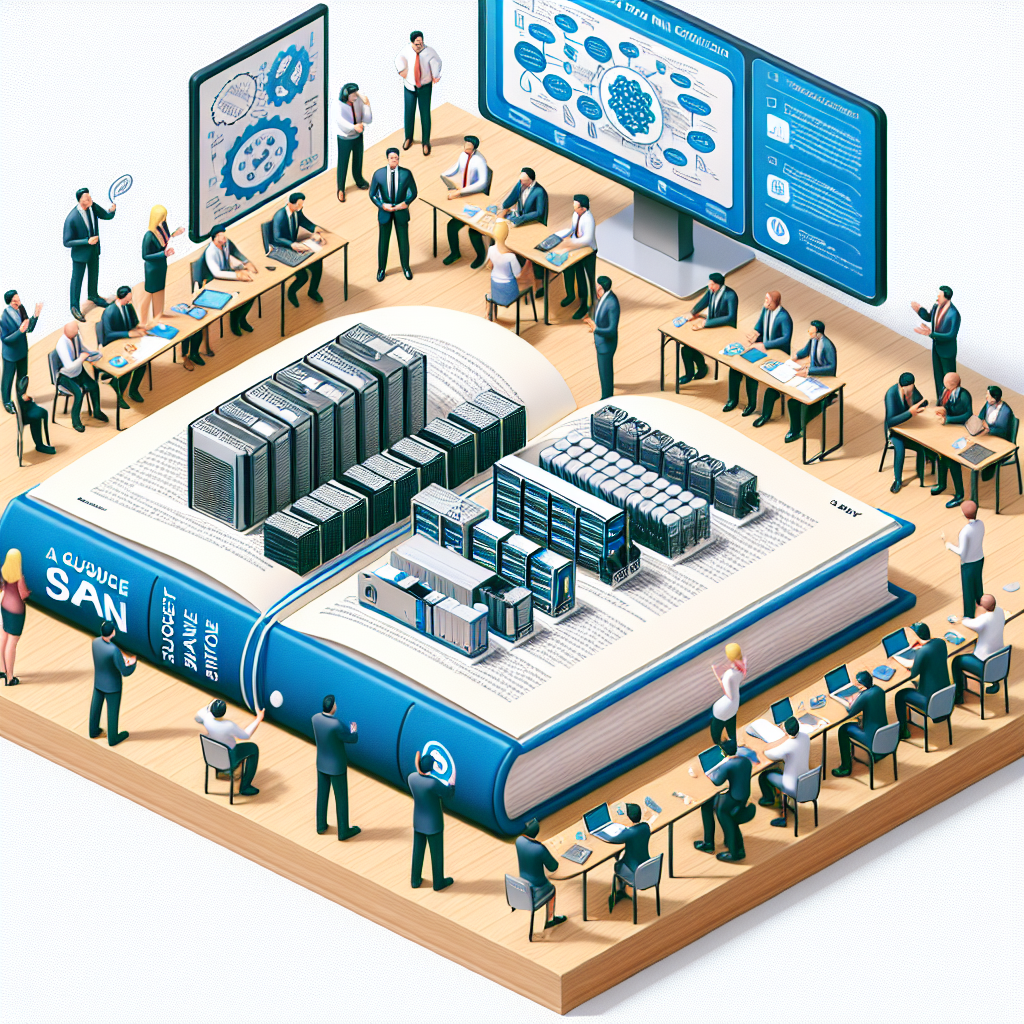Your cart is currently empty!
Tag: Organization

How to Choose the Right Storage Area Network (SAN) Solution for Your Organization
Storage Area Networks (SAN) have become an essential component for organizations looking to efficiently manage and store their data. With the increasing amount of data being generated by businesses, it is important to choose the right SAN solution that can meet the storage needs of your organization. In this article, we will discuss how to choose the right SAN solution for your organization.1. Determine your storage requirements: Before choosing a SAN solution, it is important to determine your organization’s storage requirements. Consider factors such as the amount of data you need to store, the performance requirements, and the scalability of the solution. This will help you narrow down your options and choose a SAN solution that meets your specific needs.
2. Consider your budget: SAN solutions can vary greatly in price, so it is important to consider your budget when choosing a solution. Determine how much you are willing to spend on a SAN solution and look for options that fit within your budget. Keep in mind that investing in a high-quality SAN solution can save you money in the long run by providing reliable and efficient storage for your organization.
3. Evaluate performance and scalability: When choosing a SAN solution, it is important to evaluate the performance and scalability of the solution. Look for a solution that offers high performance and can easily scale to meet the growing storage needs of your organization. Consider factors such as the speed of data transfer, the number of connected devices, and the ability to expand storage capacity as needed.
4. Consider data protection and security: Data protection and security are crucial considerations when choosing a SAN solution. Look for a solution that offers features such as data encryption, data replication, and data backup to ensure the safety and security of your organization’s data. Consider the level of data protection and security offered by different SAN solutions and choose one that meets your organization’s specific requirements.
5. Evaluate vendor support and reliability: When choosing a SAN solution, it is important to evaluate the reliability and support offered by the vendor. Look for a vendor with a good reputation for providing reliable and high-quality SAN solutions. Consider factors such as the vendor’s track record, customer reviews, and the level of support and maintenance offered by the vendor.
In conclusion, choosing the right SAN solution for your organization requires careful consideration of your storage requirements, budget, performance and scalability, data protection and security, and vendor support and reliability. By taking the time to evaluate these factors and choose a SAN solution that meets your organization’s specific needs, you can ensure that your data is stored efficiently and securely.

Creating a Culture of Proactive Maintenance in Your Organization
Proactive maintenance is a strategy that involves identifying and addressing potential issues before they become a problem. By implementing a culture of proactive maintenance in your organization, you can save time, money, and resources in the long run. Here are some tips for creating a culture of proactive maintenance in your organization.First and foremost, it is essential to develop a solid maintenance plan. This plan should outline the frequency of maintenance tasks, the resources needed, and the responsibilities of each team member. By having a clear plan in place, employees will know what is expected of them and can work together to ensure that maintenance tasks are completed in a timely manner.
It is also important to prioritize maintenance tasks based on their level of importance. Some tasks may be more critical than others and should be addressed first. By prioritizing tasks, you can ensure that the most critical issues are addressed promptly, reducing the risk of downtime or equipment failure.
Another key aspect of creating a culture of proactive maintenance is to invest in the right tools and technology. By using predictive maintenance tools, such as sensors and monitoring systems, you can track the performance of equipment in real-time and identify potential issues before they cause a breakdown. Investing in the right tools can help you save time and resources in the long run by preventing costly repairs and downtime.
In addition to investing in the right tools, it is crucial to provide training and support to employees. By educating team members on the importance of proactive maintenance and providing them with the necessary skills and knowledge, you can empower them to take ownership of maintenance tasks and work together to keep equipment running smoothly.
Finally, it is important to establish a culture of accountability within your organization. By holding employees accountable for their maintenance tasks and setting clear expectations, you can ensure that everyone is working towards the common goal of preventing breakdowns and maximizing equipment performance.
In conclusion, creating a culture of proactive maintenance in your organization can help you save time, money, and resources in the long run. By developing a solid maintenance plan, prioritizing tasks, investing in the right tools and technology, providing training and support to employees, and establishing a culture of accountability, you can work together to keep equipment running smoothly and prevent costly breakdowns.

Choosing the Right Hybrid Cloud Provider for Your Organization
Hybrid cloud solutions have become increasingly popular among organizations seeking to balance the flexibility of public cloud services with the security and control of private on-premises infrastructure. However, choosing the right hybrid cloud provider for your organization can be a daunting task with so many options available in the market.Here are some key factors to consider when selecting a hybrid cloud provider:
1. Security and Compliance: Security should be a top priority when choosing a hybrid cloud provider. Look for a provider that offers robust security measures such as encryption, access controls, and regular security audits. Additionally, make sure the provider is compliant with relevant industry regulations and standards to ensure the protection of your data.
2. Performance and Reliability: The performance and reliability of the hybrid cloud provider’s infrastructure are crucial for ensuring seamless operations. Look for a provider that offers high availability, low latency, and strong network connectivity to minimize downtime and ensure optimal performance for your applications and workloads.
3. Scalability and Flexibility: One of the key benefits of hybrid cloud solutions is the ability to scale resources up or down based on your organization’s needs. Make sure the provider offers flexible pricing models and scalability options to accommodate your growth and changing requirements.
4. Integration and Compatibility: Ensure that the hybrid cloud provider’s infrastructure is compatible with your existing systems and applications. Look for providers that offer seamless integration with popular platforms and tools to minimize disruption and facilitate a smooth transition to the hybrid cloud environment.
5. Support and Service Level Agreements (SLAs): Choose a hybrid cloud provider that offers responsive customer support and clear service level agreements (SLAs) to guarantee a high level of service and support in case of any issues or outages. Make sure the provider has a track record of meeting SLAs and providing timely resolutions to any issues that may arise.
6. Cost and Value: Finally, consider the cost and value proposition of the hybrid cloud provider. Compare pricing plans, features, and benefits offered by different providers to find the best fit for your organization’s budget and requirements.
In conclusion, choosing the right hybrid cloud provider for your organization requires careful consideration of security, performance, scalability, integration, support, and cost factors. By evaluating these key criteria and conducting thorough research, you can select a provider that meets your organization’s needs and helps you leverage the benefits of hybrid cloud technology effectively.

4 PACK Magnetic Spice Rack Organizer Storage Shelf Holder Kitchen Organization

4 PACK Magnetic Spice Rack Organizer Storage Shelf Holder Kitchen Organization
Price : 30.28
Ends on : N/A
View on eBay
Are you tired of rummaging through your messy spice cabinet every time you cook? Say goodbye to cluttered countertops and disorganized shelves with our 4 PACK Magnetic Spice Rack Organizer Storage Shelf Holder!This sleek and space-saving solution is perfect for keeping your spices, herbs, and seasonings easily accessible and neatly organized. The magnetic design allows you to easily attach the racks to your fridge or any metal surface, saving precious counter and cabinet space.
With four individual shelves, you can store a variety of spices and condiments, making meal prep a breeze. The durable construction ensures that your spices stay securely in place, while the modern design adds a stylish touch to your kitchen decor.
Don’t wait any longer to streamline your kitchen organization – get your hands on our 4 PACK Magnetic Spice Rack Organizer Storage Shelf Holder today!
#PACK #Magnetic #Spice #Rack #Organizer #Storage #Shelf #Holder #Kitchen #Organization, Magnetic storage
The Benefits of Implementing ONTAP Data Management Software in Your Organization
In today’s fast-paced business environment, data management is more important than ever. Organizations are generating and collecting vast amounts of data every day, and it is crucial to have a system in place to manage and protect this valuable information. This is where NetApp’s ONTAP data management software comes in.ONTAP is a powerful data management software solution that helps organizations efficiently store, protect, and manage their data. By implementing ONTAP in your organization, you can enjoy a range of benefits that will help streamline your operations and improve overall efficiency.
One of the key benefits of ONTAP is its ability to provide unified storage management. With ONTAP, organizations can consolidate their storage infrastructure into a single, easy-to-manage platform. This allows for more efficient use of resources and simplifies the management of data across different storage systems.
Another benefit of ONTAP is its advanced data protection features. ONTAP includes built-in data protection mechanisms such as snapshot technology, which allows organizations to quickly recover data in the event of a disaster or data loss. This can help minimize downtime and ensure that critical data is always available when needed.
ONTAP also offers advanced data replication capabilities, allowing organizations to easily replicate and move data between different storage systems. This can be particularly useful for organizations with multiple data centers or remote offices, as it enables them to ensure data consistency and availability across their entire network.
In addition to its data management capabilities, ONTAP also offers powerful data analytics tools. These tools allow organizations to gain valuable insights into their data, helping them make more informed decisions and optimize their operations. By leveraging these analytics tools, organizations can identify trends, patterns, and opportunities within their data, leading to improved efficiency and productivity.
Overall, implementing ONTAP data management software in your organization can have a significant impact on your operations. From simplifying storage management to enhancing data protection and analytics capabilities, ONTAP offers a comprehensive solution for organizations looking to streamline their data management processes. If you want to stay ahead in today’s data-driven world, ONTAP is the way to go.

Process Consultation: Its Role in Organization Development, Volume 1…

Process Consultation: Its Role in Organization Development, Volume 1…
Price : 5.51
Ends on : N/A
View on eBay
Process Consultation: Its Role in Organization Development, Volume 1Process consultation is a key concept in organization development, focusing on the process of communication and interaction within an organization. This volume explores the role of process consultation in helping organizations improve their effectiveness and achieve their goals.
In this book, readers will find practical guidance on how to use process consultation to identify and address issues within an organization, improve communication and collaboration among team members, and facilitate organizational change. Case studies and real-world examples illustrate the concepts and techniques discussed, making this book a valuable resource for consultants, managers, and anyone interested in improving organizational performance.
Whether you are a seasoned consultant looking to enhance your skills or a manager seeking to improve your team’s effectiveness, Process Consultation: Its Role in Organization Development, Volume 1 is a must-read for anyone interested in using process consultation to drive positive change within their organization.
#Process #Consultation #Role #Organization #Development #Volume #1.., IT Consulting
Key Considerations for Implementing All-Flash Storage in Your Organization
In today’s fast-paced digital world, organizations are constantly looking for ways to improve their storage infrastructure to keep up with the increasing demands of data storage and processing. One solution that has gained popularity in recent years is all-flash storage. All-flash storage arrays use flash memory instead of traditional spinning hard drives, offering faster performance, lower latency, and higher reliability. However, implementing all-flash storage in your organization is not as simple as just purchasing the hardware. There are several key considerations that need to be taken into account to ensure a successful deployment.First and foremost, it is important to assess your organization’s specific storage needs and requirements. Consider factors such as the amount of data you need to store, the performance requirements of your applications, and the level of reliability and availability needed for your storage infrastructure. This will help you determine the capacity and performance specifications of the all-flash storage array that will best meet your organization’s needs.
Another key consideration is the cost of implementing all-flash storage. While the prices of flash storage have significantly decreased in recent years, they are still generally more expensive than traditional spinning hard drives. It is important to carefully evaluate the total cost of ownership, including not just the upfront hardware costs but also factors such as power consumption, maintenance, and potential upgrades in the future.
Integration with existing infrastructure is also a crucial consideration when implementing all-flash storage. Make sure that the all-flash storage array is compatible with your organization’s existing hardware and software systems. Consider factors such as the operating system, storage management software, and networking infrastructure to ensure a seamless integration and minimal disruption to your organization’s operations.
Scalability is another important consideration when implementing all-flash storage. Make sure that the all-flash storage array can easily scale to accommodate future growth in data storage needs. Look for features such as the ability to add more storage capacity or performance resources as needed without requiring a complete overhaul of the storage infrastructure.
Lastly, consider the level of support and service offered by the all-flash storage vendor. Look for a vendor that offers comprehensive support services, including technical support, maintenance, and software updates. A reliable vendor with a proven track record of customer satisfaction can help ensure a smooth implementation and minimize downtime in case of any issues.
In conclusion, implementing all-flash storage in your organization can offer significant benefits in terms of performance, reliability, and scalability. However, it is important to carefully consider key factors such as your organization’s specific storage needs, cost considerations, integration with existing infrastructure, scalability, and vendor support before making a decision. By taking these considerations into account, you can ensure a successful implementation of all-flash storage that meets your organization’s needs and helps drive efficiency and innovation in your storage infrastructure.

Syngineering: Building Agility into Any Organization: A Do-It-Yourse – VERY GOOD

Syngineering: Building Agility into Any Organization: A Do-It-Yourse – VERY GOOD
Price : 7.36
Ends on : N/A
View on eBay
Syngineering: Building Agility into Any Organization – A Do-It-Yourself GuideIn today’s fast-paced and ever-changing world, agility has become a key factor for success in any organization. Businesses need to be able to adapt quickly to changes in the market, technology, and customer preferences in order to stay competitive.
Syngineering is a concept that combines synergy and engineering to create a more agile and efficient organization. By harnessing the power of collaboration, innovation, and continuous improvement, organizations can build the agility they need to thrive in a dynamic environment.
In this post, we will explore the key principles of Syngineering and provide a step-by-step guide for building agility into any organization. From fostering a culture of collaboration to implementing agile processes and tools, we will show you how to transform your organization into a lean, mean, agile machine.
So if you’re ready to take your organization to the next level and build a more agile and resilient business, keep reading for our Do-It-Yourself guide to Syngineering.
#Syngineering #Building #Agility #Organization #DoItYourse #GOOD, IT Consulting
Choosing the Right Cisco Firewall for Your Organization
In today’s digital age, the importance of cybersecurity cannot be overstated. With cyber threats becoming more sophisticated and prevalent, organizations must invest in robust security measures to protect their sensitive data and networks. One essential component of a comprehensive cybersecurity strategy is a firewall, which acts as a barrier between a trusted internal network and untrusted external networks.Cisco is a leading provider of network security solutions, offering a range of firewall products to meet the diverse needs of organizations of all sizes. When choosing the right Cisco firewall for your organization, there are several factors to consider to ensure you select the best option for your specific requirements.
First and foremost, it is essential to assess the size and complexity of your organization’s network. Cisco offers firewall solutions for small businesses, mid-size enterprises, and large corporations, each with varying capabilities and features. It is crucial to choose a firewall that can effectively handle the volume of traffic on your network and provide the necessary level of protection against potential threats.
Another important consideration is the level of security features offered by the firewall. Cisco’s firewall products come with a range of advanced security features, such as intrusion prevention, application control, VPN support, and advanced threat protection. Depending on your organization’s security needs, you may require specific features to safeguard your network from various cyber threats.
Additionally, it is essential to consider the scalability and flexibility of the firewall. As your organization grows and evolves, your cybersecurity needs will also change. Choosing a firewall that can easily scale to accommodate additional users, devices, and applications will ensure that your network remains secure and protected in the long run.
Furthermore, it is crucial to assess the ease of management and deployment of the firewall. Cisco offers firewall solutions that are designed to be user-friendly and easy to configure, making it simple for IT teams to implement and manage the security policies effectively. Choosing a firewall that is intuitive and straightforward to use will help streamline the management of your organization’s cybersecurity infrastructure.
Lastly, cost is a significant factor to consider when selecting a Cisco firewall for your organization. It is essential to weigh the upfront costs of purchasing the firewall against the long-term benefits of enhanced security and protection. Additionally, consider ongoing maintenance and support costs to ensure that your organization can afford to maintain and update the firewall regularly.
In conclusion, choosing the right Cisco firewall for your organization is a critical decision that requires careful consideration of your organization’s unique needs and requirements. By assessing factors such as network size, security features, scalability, ease of management, and cost, you can select a firewall that provides the necessary protection for your organization’s sensitive data and networks. With the right Cisco firewall in place, you can rest assured that your organization is well-equipped to defend against cyber threats and safeguard your valuable assets.

